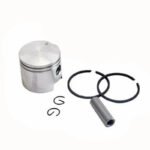The Importance of Regular Equipment Inspections
Introduction
For farmers, landscapers, DIY enthusiasts, and agricultural product makers, maintaining the integrity of outdoor power equipment is essential. Regular equipment inspections are not just a matter of good practice; they are crucial for safety, efficiency, and cost-effectiveness. Drawing from ancient farming techniques and their enduring relevance today, we can gain valuable insights into how consistent maintenance routines can benefit modern agricultural practices.
Historical Context: Ancient Farming Techniques
Ancient farming techniques have much to teach us about sustainable and effective farming. These time-tested methods were developed to ensure that tools and machinery functioned optimally, reflecting the importance of regular maintenance in achieving long-term success.
- Crop Rotation: Ancient farmers rotated crops to maintain soil fertility and reduce the risk of disease. This technique indirectly protected their tools and equipment by ensuring a consistent and healthy environment for usage.
- Irrigation Systems: Early irrigation methods required meticulous maintenance to ensure that water reached the crops efficiently. Regular inspections of these systems were vital in preventing blockages and ensuring optimal performance.
- Mixed Cropping: Planting different crops together helped in pest management and soil health. This holistic approach extended to the care and maintenance of farming tools, ensuring they remained in good condition for various tasks.
Modern-Day Relevance
While we live in a technologically advanced era, the principles behind ancient farming techniques remain relevant. Today’s equipment might be more sophisticated, but the need for regular inspections and maintenance is unchanged. Integrating these time-tested methods with modern practices can lead to enhanced sustainability and efficiency.
- Sustainability: Just as ancient farmers aimed to sustain their land and tools, modern practices must focus on sustainability. Regular inspections help in identifying issues early, reducing waste and extending the lifespan of equipment.
- Efficiency: Consistent maintenance routines, inspired by ancient practices, can improve efficiency. Well-maintained equipment performs better, reducing downtime and increasing productivity.
The Importance of Regular Inspections
Regular inspections of farming and landscaping equipment are critical for several reasons:
- Preventative Maintenance:
- Identifying Wear and Tear: Regular inspections help in spotting signs of wear and tear early. This proactive approach prevents minor issues from becoming major problems.
- Replacing Worn Parts: Timely replacement of worn-out parts ensures that equipment continues to function effectively, reducing the risk of unexpected breakdowns.
- Safety:
- Preventing Accidents: Equipment that is regularly inspected and maintained is less likely to malfunction, reducing the risk of accidents and injuries.
- Ensuring Compliance: Adhering to safety regulations through regular inspections ensures compliance with industry standards, protecting both users and operators.
- Cost Savings:
- Reducing Repair Costs: Early detection of issues through regular inspections can save significant repair costs by addressing problems before they escalate.
- Extending Equipment Lifespan: Well-maintained equipment lasts longer, providing better return on investment and reducing the need for frequent replacements.
- Productivity:
- Minimizing Downtime: Regular maintenance reduces the likelihood of equipment failure, ensuring continuous operation and maximizing productivity.
- Enhancing Performance: Properly maintained equipment performs at its best, increasing efficiency and output.
What to Check During Inspections
Conducting thorough inspections involves checking various components to ensure optimal performance:
- Brakes and Safety Features:
- Inspect Brake Functionality: Ensure that brakes are responsive and in good condition.
- Check Safety Mechanisms: Verify that all safety features, such as emergency shut-offs, are operational.
- Fluid Levels:
- Check Oil Levels: Ensure that oil levels are adequate and the oil is clean.
- Inspect Coolant and Hydraulic Fluids: Verify that these fluids are at the correct levels and are free from contaminants.
- Wear and Tear:
- Examine Belts and Hoses: Look for signs of cracks, fraying, or other damage.
- Inspect Tires and Tracks: Check for proper inflation and any signs of wear or damage.
- Cleanliness:
- Remove Dirt and Debris: Clean equipment thoroughly to prevent rust and other damage.
- Inspect Filters: Ensure air and oil filters are clean and functioning properly.
Proper Storage Techniques
Storing equipment properly is as important as regular inspections. Proper storage techniques help in maintaining equipment in good condition and ready for use.
- Clean and Dry:
- Thorough Cleaning: Clean equipment thoroughly before storage to remove dirt and debris.
- Drying: Ensure equipment is completely dry to prevent rust and corrosion.
- Covering:
- Use Protective Covers: Cover equipment to protect it from dust, moisture, and other environmental factors.
- Storage Location: Store equipment in a sheltered, dry location to prevent exposure to the elements.
- Organization:
- Keep Tools Organized: Store tools and parts in an organized manner to make them easily accessible.
- Label Storage Areas: Label storage areas for quick identification and retrieval of equipment.
Conclusion
Regular equipment inspections and proper maintenance routines are vital for ensuring the longevity, safety, and efficiency of your tools. By drawing inspiration from ancient farming techniques, we can adopt sustainable practices that enhance the performance of modern equipment. Whether you’re a farmer, landscaper, DIY enthusiast, or agricultural product maker, integrating these practices into your routine will lead to better productivity and cost savings.
We encourage you to share your experiences with equipment maintenance and inspections. Visit lakparts.com for more resources and guides on preventative maintenance and proper storage. Let’s work together to keep our tools in top shape and our gardens flourishing!
By following these guidelines, you can ensure that your equipment remains in excellent condition, ready to tackle any task with ease. Regular inspections and maintenance are the keys to successful and sustainable farming and gardening practices. For more local insights and tips, check out vagaa.lk as well.




